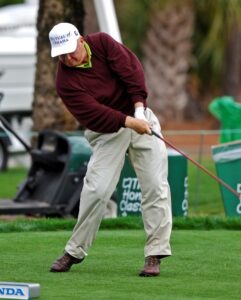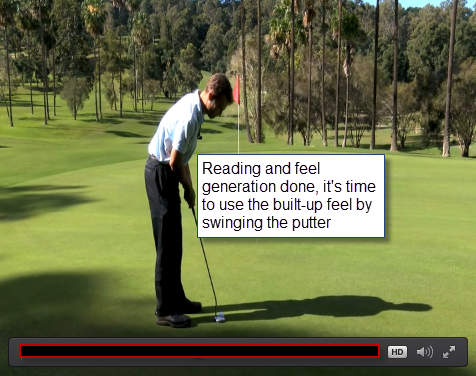What To Focus On For Consistent 27-32 Putts/Round Putting
Ted’s story…A warning to all club-golfers. And, putting tips from two of golf’s greats
Common club-golfer mistake: trying to keep your hands quiet while trying to make a perfect stroke.
Trying to make a perfect stroke sabotages all feel and any chance of getting really hot with the putter and leads to the yips.
I see this happen all the time at local golf clubs.
The following is a warning (and can be liberating) to all who are focused too much on the perfect putting stroke.
Ted
Ted, a club-golfer I know, retired at age 63 back in the 1990’s. At the time he played off a 15 handicap and would come down to 12 in the following year or two.
His putting stroke was an ugly duckling. He aimed left, took the putter outside the line going back then looped it back inside on the way through – with substantial body-action thrown in for good measure!
He didn’t spend time practicing before he retired. And his play was a weekend club-competition 18 holes and he a mid-week 9 holes after work in summer months with his sons.
He’s putting was fine. It worked because Ted had good feel, vision and tempo and he was orientated to the target.
When he retired he started playing 3 x 18 holes per week – and did so for 25 years.

Billy Mayfair
Credit: http://www.flickr.com/photos/jrpfeifler/3337182535/
His mates down at the golf club started calling him “Billy” as in Billy Mayfair, the 5-time P.G.A tour winner and only player to beat Tiger in a P.G.A tournament playoff (The 1998 Nissan Open).
Billy was at his prime during the mid-late 90’s.
Billy took the putter head outside and cut his putts.
Billy said in 2003 this about changing his putting style:
“The only change I’ve made in my putting is my putter,” said Mayfair, 36, who’s three shots off the lead. “As for changing [the stroke], I tried to do that back in ’91 and got the yips really bad from doing it.”
[Reference: http://articles.sun-sentinel.com/2003-03-09/sports/0303090138_1_faldo-foldo-stroke-six-consecutive-birdies.]
And this is exactly what happened to Ted.
And sadly, he never recovered. He could have recovered if he did what Joan did (explained here) and switched his mechanical, self conscious guiding-stroke, to the essential principles of putting: reading the line and speed to the target then reacting to it with the built-up feel.

Demonstrating what I’m explaining – in the TAP Training Course
Why did it go bad for Ted?
Because he started practicing his putting-stroke to make it look prettier.
His peers had seen something different (his stroke) and they told him so.
He practiced on the carpet at his home most days and nights – as he was retired and had ample spare time.
(Note: practice without solid objectives is worse than no practice at all.)
His stroke started looking more straight-back-and-through when practicing, but not when placed under club-competition pressure.
Unfortunately, his preoccupation with what his stroke was doing gave way to the yips.
He placed so much pressure on himself. He had developed paralysis by analysis.
In other words, his brain was far too conscious of what should be a subconscious, habitual action (stroke). When you focus too much on mechanics you short-circuit the part of the brain that is responsible for action.
Added to this is, a growing anxiety about the outcome of the putt, a lack of confidence, and a never ending, fruitless search for the secret.
Note: most golfers look in the wrong spot for the secret: a new putter, a new grip-style, a new gadget. Again, these quick-fixes take the golfer’s focus off the things that matter: reading the line and speed to the target then reacting to it with the built-up feel. Nothing game-changing, no improvement or understanding of putting systems/processes based on principles that great putters use to put well month after month, year after year.
Back to Ted…
He was brainwashed into thinking that he had to have a conventional looking putting stroke – even though the old one worked fine. (Reminder: The main objective of golf is to hit the ball into the hole in as few shots as possible. If what you do consistently works, don’t change. You will see throughout this site I talk ad nauseam about the essentials of Putting: Reading, Routine, Reacting freely to what you have read, and reviewing the first 3 R s ).
This should be a warning to all golfers, you might not develop the yips, but if you are currently thinking about your stroke and hands while putting, you are needlessly adding many shots to every round and to the pressure you feel.
Below, a video review I created years ago on an Ernie Els and Gary Player Putting video. They talk about The Truth About Great Putting.
Key points from the video:
1. Gary Player basically says your stroke, style of stance doesn’t matter; great putters have used different and not-so-perfect strokes and techniques (as I mentioned on the previous page).
2. The key ingredients great putters focus on to roll the ball into the hole: Speed/Feel and Line.
3. Ernie talks about how he had been struggling with his putting because his ROUTINE had changed. And most importantly the time from between his last look at the hole and when he pulled the trigger had got longer. It is vital to look then react without delay. (I write, talk and and demonstrate this in detail in The Truth About Putting.)
Note that Ernie in turned his putting from diabolical late in his competitive P.G.A career, to good enough to win the 2012 British Open. He did this on the back of working with a visualization coach.
The putting stroke is an extremely simple action, anyone, regardless of their handicap can putt very well given the right keys to focus on.
For more on the optimal putting routine, mastering long and short putting, green reading and putting well under pressure, The Truth About Putting Course covers it all.
Cheers,
Anthony
